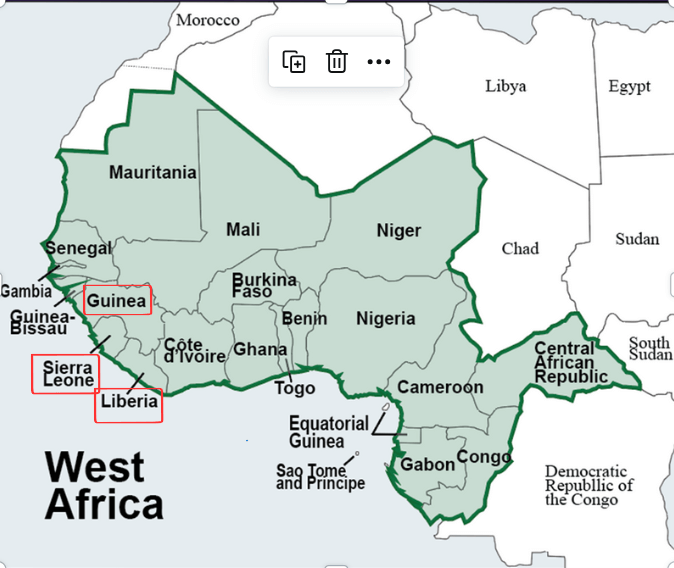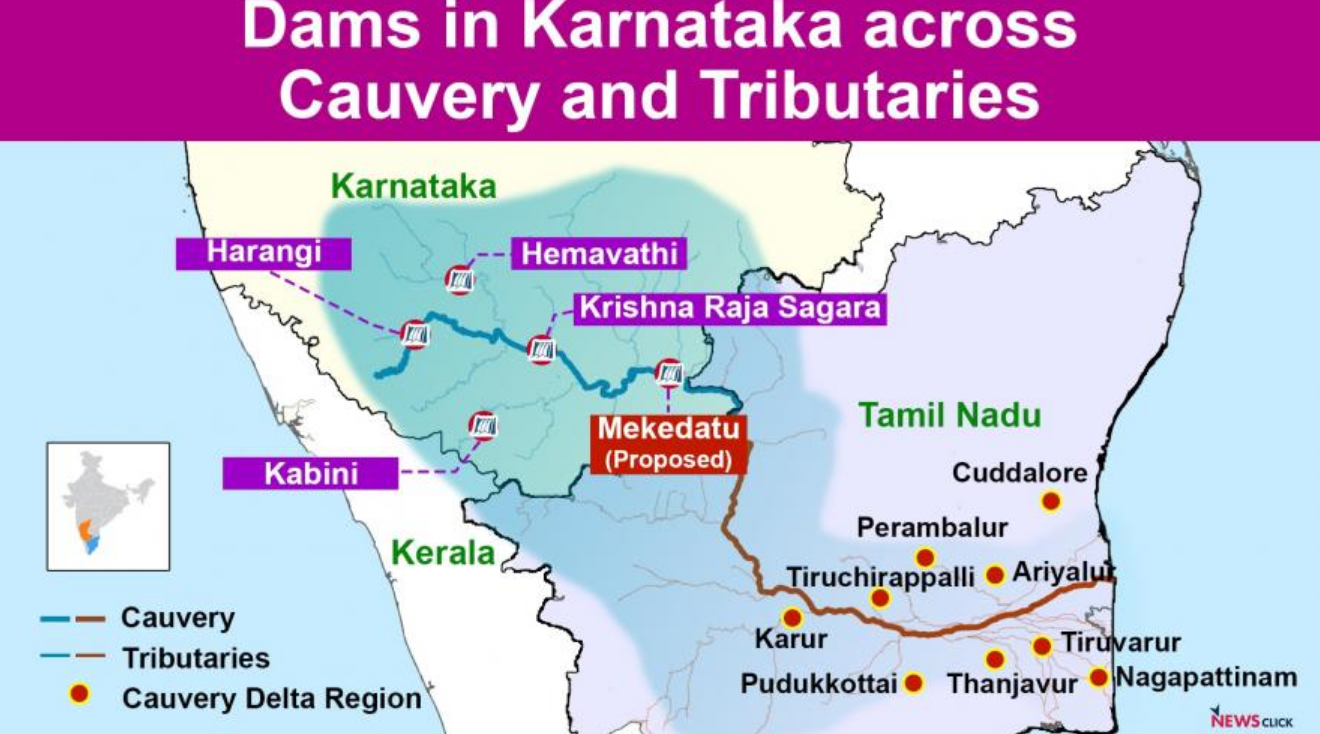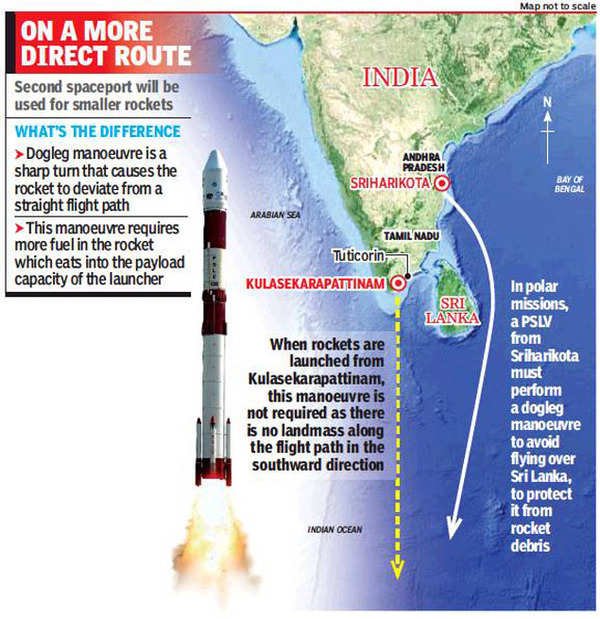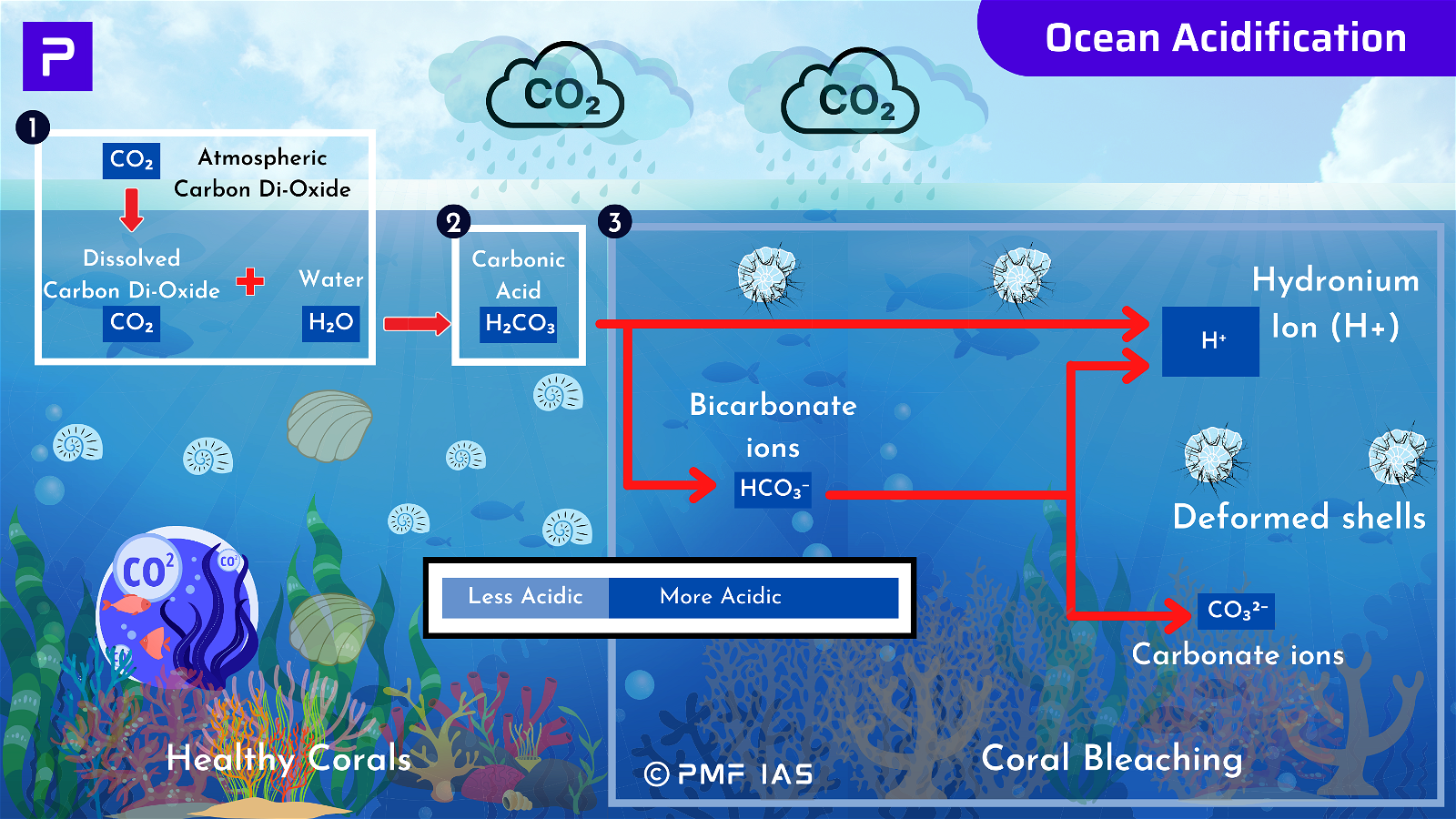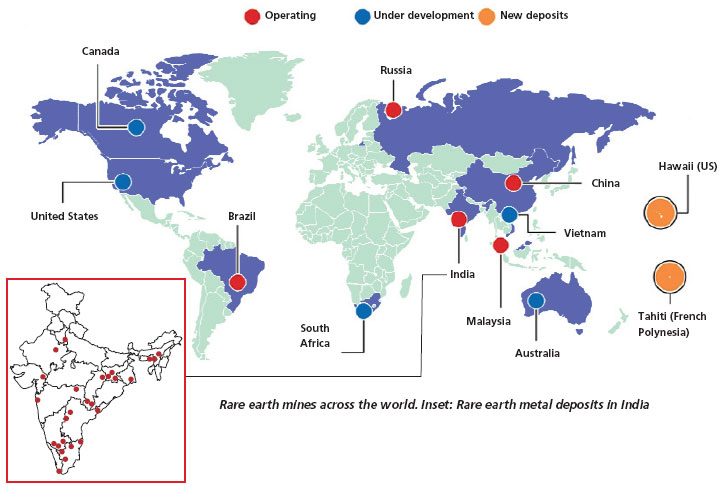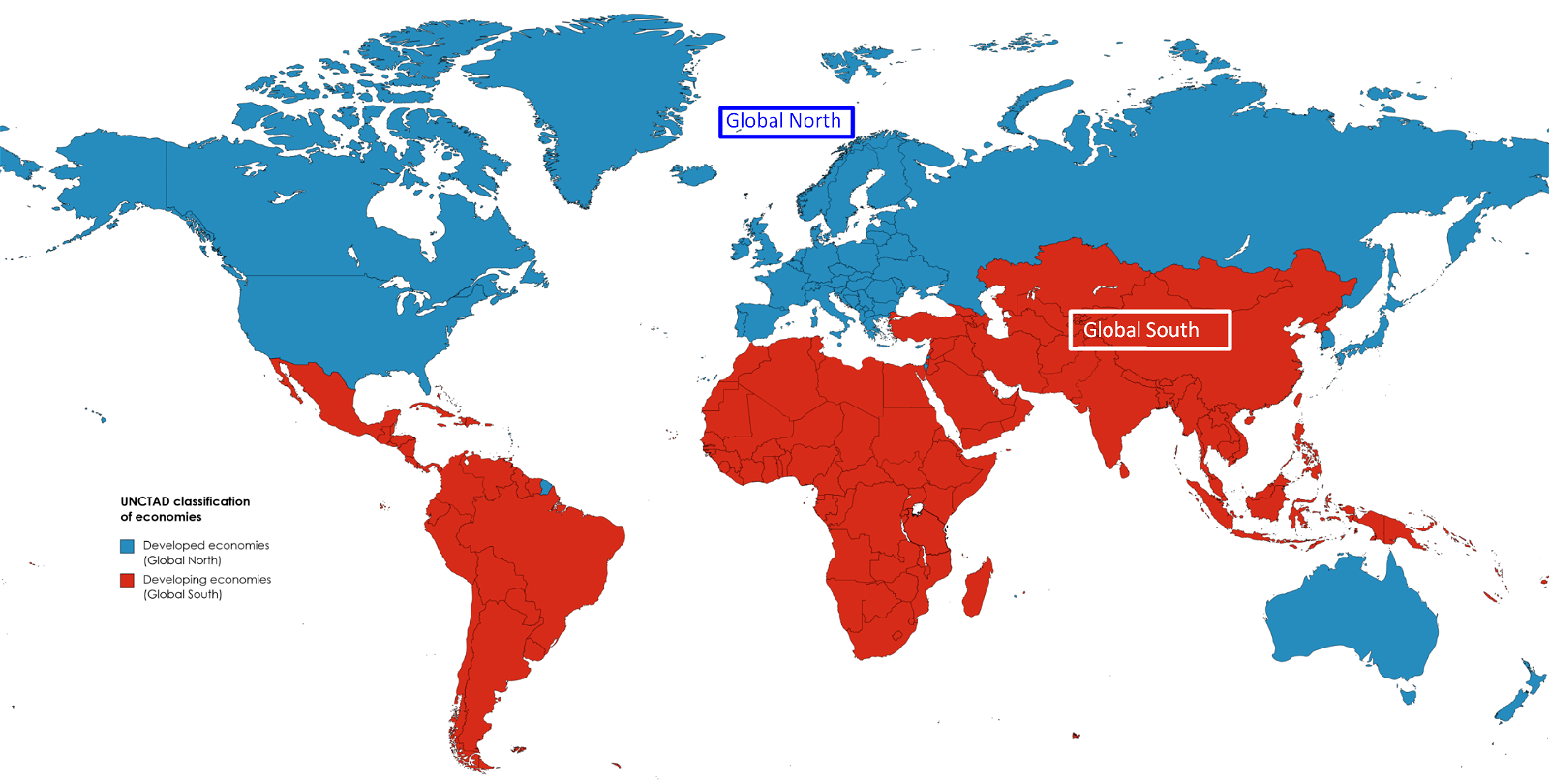
Current Affairs December 15, 2023: Toxic Masculinity, E-Waste Management Rules, 2022, By-Elections, Interlinking of Rivers, Delisting Parties with Religious Names, E-Cigarettes, Logistics Sector in India
Subscribers of "Current Affairs" course can Download Daily Current Affairs in PDF/DOC
Subscribe to Never Miss an Important Update! Assured Discounts on New Products!
Must Join PMF IAS Telegram Channel & PMF IAS History Telegram Channel
{GS1 – A&C – Schemes} National Mission for Manuscripts
- Context (TH): The National Mission for Manuscripts documented approx. 5.2 million manuscripts having ancient scripts.
- It was established in 2003 by the Ministry of Culture.
- Nodal body: Indira Gandhi National Centre for the Arts (IGNCA). It is an autonomous institution under the Ministry of Culture. It was established in 1987 as a centre for research, academic pursuit and dissemination in the field of the arts.
- Motto: ‘Conserving the past for the future’.
Objective
- Surveying, locating, and preserving Indian manuscripts.
- Creating a national database of all Indian manuscripts.
- Increasing access to and awareness of manuscripts for educational purposes.
Manuscripts
|
{GS1 – Geo – EG} Interlinking of Rivers
- Context (PIB): Minister of Jal Shakti chaired 21st Meeting of Special Committee for Interlinking of Rivers.
- It is an initiative to transfer water from water-surplus regions to water deficient & rain-fed areas through inter-basin transfers, to ensure greater equity in the distribution of water.
- ILRs are identified by the National Water Development Agency (NWDA), under the National Perspective Plan (NPP).
- Nodal Ministry: Ministry of Jal Shakti.
- Components under NPP: It includes two components, which comprises 30 links;
- 14 links under the Himalayan Rivers Component and
- 16 links under the Peninsular Rivers Component.
- Objective: To connect more than 60 rivers across India through a network of storage dams to form a gigantic South Asian Water Grid.
National Perspective Plan
|

Significance of Interlinking of Rivers
- Redistributing water flow: Flood control in the Ganga-Brahmaputra-Meghna basin and drought control in the western and peninsular states such as Rajasthan, Gujarat, AP, Karnataka and TN
- Improved irrigation facilities in the water-scarce western and peninsular region, thereby increasing agriculture productivity, leading to enhanced food security and doubling of farmers’ income.
- Hydropower potential: It would add approx. 34,000 MW of hydropower to the energy pool of the nation addressing the electricity woes of industrial, agricultural, and rural households.
- Commercial benefits: Creation of logistics infrastructure, enable freight movement through environmentally friendly inland waterways.
- Sustainable development: It would help address the critical groundwater situation in the country by utilizing surface water and preventing flow of freshwater into the sea.
- Other benefits: Reduced burden on women to fetch water from long distances, employment opportunities in rural areas, multiply benefits through backward and forward linkages, etc.
Challenges with Interlinking of Rivers
- Environmental challenges: It may result in evaporation losses, water logging & salinity, and land submergence. For eg: Ken Betwa link may imperil areas of Panna National Park.
- ‘Developmental Displacement’
- Lack of Transparency and Information: Conclusive feasibility studies of the project have not been conducted in detail, nor have its economic, social and ecological implications been assessed.
- Impact of Climate change: Changing rainfall pattern with changing climate makes the implementation and achievement of intended benefits of ILR projects uncertain.
- Federal aspects: Water being a state subject, it is difficult to resolve issues of water sharing between states. For eg, Kerala and Tamil Nadu.
- Challenges in coordination with neighbouring countries like Bhutan, Nepal and Bangladesh.
- Unexplored alternatives such as watershed development, rainwater harvesting, optimising existing infrastructure and cropping methods could well address the water woes of the country.
Way Forward
- Scientific and technical assessment of the project to make it techno-economically feasible.
- Rehabilitation & relief package to resolve ‘developmental displacement’ issue.
- Including local communities, farmers, environmentalists, and state governments in the planning and implementation of the project.
- Assessing the ecological impact of interlinking rivers and ensure that sensitive ecosystems, biodiversity, and wildlife habitats are protected.
- Phased implementation based on feasibility, benefits, & minimal environmental-social impacts.
National Interlinking of Rivers Authority
|
{GS1 – Indian Society – Issues} Toxic Masculinity
- Concept: Toxic masculinity (Kabir Singh and Animal) is a concept that highlights certain harmful behaviours and attitudes associated with traditional stereotypes of masculinity.
- It refers to societal expectations and pressures on men to conform to specific norms (for example, man is the family’s breadwinner) that can be damaging to both men and the society.
How is toxic masculinity manifested/reflected in the society?
- Emotional suppression: Men are conditioned to suppress emotions, except for anger or aggression, as showing vulnerability or sensitivity is seen as a sign of weakness.
- Limited range of expression: Toxic masculinity restricts the range of behaviours deemed acceptable for men. Empathy, nurturing, or affection are often discouraged or considered unmanly.
- Dominance and aggression: Traits like dominance (Alpha Male!), aggression, and toughness are glorified. Men are often taught that they must assert power or control over others, leading to aggressive behaviour that perpetuates violence or conflict (Related: Decoding the mind of a rapist).
Impacts of Toxic Masculinity
Mental health issues
- Emotional repression can lead to increased stress, anxiety, depression, and even suicidal tendencies.
- The pressure to conform to stereotypical male norms prevents many from seeking help or expressing their emotional struggles, exacerbating mental health issues.
Relationship challenges
- Toxic masculinity affects how men relate to others, especially in intimate relationships.
- Difficulty expressing emotions and lack of empathy can strain relationships, leading to communication breakdowns, emotional distance, and increased conflict.
Violence and aggression
- The glorification of dominance/aggression in toxic masculinity contributes to a culture of violence.
- Men may feel compelled to resolve conflicts through aggression or violence, perpetuating a cycle of harm that affects not only themselves but also their communities.
Societal consequences
- Toxic masculinity perpetuates systemic issues such as gender inequality, reinforcing power imbalances and limiting opportunities for both men and women.
- It also hinders progress towards gender equality and inclusivity, impacting social structures and cultural attitudes.
Self-image and identity struggles
- Men adhering to toxic masculinity often face internal conflicts as they struggle to reconcile societal expectations with their authentic selves. This conflict between conforming to societal norms and expressing their true identities can lead to insecurity and self-doubt.
Impact on women and LGBTQ+ Individuals
- Toxic masculinity reinforces gender stereotypes and expectations, leading to discrimination, sexism, and misogyny.
- It can manifest as controlling behaviour, objectification of women, and the perpetuation of harmful stereotypes.
- Moreover, it contributes to the stigmatisation and marginalisation of LGBTQ+ individuals who don’t conform to traditional gender norms.
Methods to Overcome Toxic Masculinity
Education and Awareness
- Promoting education and awareness programs in schools, workplaces, and communities that challenge traditional gender roles and stereotypes.
- Encouraging discussions about masculinity, the effects of rigid gender norms and gender equality.
Redefining masculinity
- Encouraging a broader definition of masculinity, including emotional intelligence, empathy, and nurturing qualities.
- Highlighting and celebrating diverse representations of masculinity to counter stereotypes and provide positive role models.
Others
- Encouraging emotional expression: Creating safe spaces for men to express emotions and vulnerability and seek help without fear of judgment or stigma.
- Challenging behaviours that perpetuate sexism, misogyny, homophobia, and transphobia.
- Promoting healthy relationships: Encouraging healthy communication and empathy in relationships, emphasising the value of emotional intimacy and mutual understanding.
- Supportive networks and role models: Fostering supportive networks where men can engage in open dialogue, share experiences, and support each other in challenging toxic masculinity.
- Policy and institutional changes: Advocating for policies that promote gender equality, support diversity, and discourage gender-based discrimination in institutions and workplaces.
{GS2 – MoCI – Initiatives} Government e-Marketplace (GeM)
- Context (IE): Central Public Sector Enterprises procurement through Government e-Marketplace (GeM) surpasses INR 1 lakh crore in 6.5 months of FY 23-24.
- It is the Public Procurement Portal for procuring goods and services for all Central and State Government Ministries, Departments, Public Sector Units (PSUs), etc.
- It was launched in 2016 to bring transparency and efficiency to the government buying process.
- It is a 100 per cent GoI-owned company set up under the aegis of the Ministry of Commerce.
- In 2017, GoI made it mandatory for all ministries to procure goods/services from the GeM.
Advantages of GeM
- Increased Public Savings: An independent assessment by the World Bank reported that GeM enabled an average savings of 9.75% on the median price between February 2019 and January 2020.
- Aatmanirbhar Bharat: In 2020, GeM made it mandatory for sellers to enter the Country of Origin while registering products on GeM to promote ‘Make in India’ and ‘Aatmanirbhar Bharat’.
- Enabling MSMEs to Scale Up: The portal allows MSMEs to scale up their business and increase sales.
{GS2 – MoHUA – Schemes} PM SVANidhi Scheme
- Context (PIB): A recent study by SBI has hailed the PM SVANidhi Scheme’s performance, stating that 43% of beneficiaries are women street vendors.
About the Scheme
- It is a micro-credit scheme launched by the central government for urban street vendors.
- The scheme was launched during the COVID-19 pandemic 2020 by the Ministry of Housing and Urban Affairs (MoUHA) and provides collateral-free loans up to Rs 50,000 for eligible street vendors in incremental tranches: first tranche of Rs 10,000, second tranche of Rs 20,000 subject to repayment of the first tranche, and third tranche of Rs 50,000 upon repayment of the second loan.
- PM SVANidhi has helped promote inclusive entrepreneurship and proven to be a gender equaliser.
How did the scheme ensure Inclusive Entrepreneurship?
- PM SVANidhi has seamlessly connected marginalised urban micro-entrepreneurs, breaking down community barriers.
- Almost 75% of loan beneficiaries come from the non-general category.
- OBCs account for 44% of total disbursement, while SCs/STs account for 22%
- 65% of the borrowers in PM SVANidhi are in the age group of 26-45.
- Behavioral Shift for Digital Acceptability: PM SVANidhi loans, when given to Jan Dhan beneficiaries, migrate at least 9.5% of people doing less than 10 transactions into higher digital transactions.
{GS2 – Polity – IC – Elections} By-Elections
- Context (IE): The Bombay HC directed the Election Commission of India (ECI) to immediately conduct a by-poll for the Pune Lok Sabha constituency.
- A plea was filed against a certificate issued by the ECI to not hold a by-poll to the constituency.
- ECI argued that the complainant had no locus standi (legal standing) to file a writ petition and instead should have filed a PIL.
ECI’s Response
- In case by-polls are held, the returned candidate would hardly have three months to work as an MP.
- It had a “genuine difficulty” in conducting the by-poll as its whole machinery was far too busy with preparations for Lok Sabha elections 2024.
HC’s Observation
- Petitioner had a locus to file a writ petition being a voter of the said constituency.
- ECI’s powers were never ‘unbridled or exempted’ from judicial review.
- Constituencies cannot remain unrepresented beyond a defined period and the same is “wholly unconstitutional”.
- ECI should only function within a principle of “right to representation”.
About By-Elections/Bypolls
- Bypolls, or special elections, refer to elections held to fill vacant seats in the legislative bodies of India.
- The primary objective of by-polls is to ensure the timely filing of vacant seats, enabling the representation of the affected constituency or district in the legislative body.
- Bypolls are conducted when a seat in the legislature becomes vacant due to reasons such as the
- Death,
- Resignation,
- Disqualification, or
- Expulsion of a sitting member.
RPA, 1951 on By-Elections
- Section 151A of RPA prescribes that the by-elections shall be held within six months from the date of the occurrence of the vacancy.
- Exceptions:
- Section 151A (a): Six-month rule will not apply when the remainder of the Parliament term is less than one year.
- Section 151A (b): To not hold by-polls is a consultation between EC and the Central government, certifying ‘difficulty’ to hold the same within six months.
|
Impact of By-Polls
- Bypolls serve as a significant indicator of the popularity and strength of political parties.
- Political parties can use bypolls to measure public sentiment and assess their support base.
- The outcomes of by-elections can have an impact on the ruling government’s majority.
- If the ruling party loses a substantial number of bypoll seats, it may lead to a loss of the government’s stability and decision-making.
- Bypolls offer a platform for political parties to experiment with their electoral strategies and refine their campaign approaches.
- Parties can test various aspects such as candidate selection, campaign themes, and messaging during by-polls that can influence their strategies in subsequent elections.
{GS2 – Polity – IC – Elections} Delisting Parties with Religious Names
- Context (TH I IE): The Delhi HC observed that the De-registration of political parties having names with caste, religious, ethnic, or linguistic connotations has to be decided by the Parliament.
- The PIL by petitioner sought cancellation of political parties having religious symbols and names.
Arguments by the Petitioner
- The use of names with religious connotations or symbols might prejudicially affect the poll prospects of a candidate & amount to corrupt practice under the Representation of the People Act (RPA), 1951.
- Political parties are required to abide by the principle of secularism as mandated by Section 29A of RPA,1951.
- It also violates “Free and fair elections” which is part of the Basic Structure of the Constitution.
|
SC’s Observation
- “Using such a name is not enough. Parties having a different name may be far more communal.
- HC remarked that the matter is in the “policy domain” and is outside the judiciary’s ambit.
Theory of Separation of Power
|
Election Commission’s (EC) Response
- The EC maintained that “there is no express provision which bars associations with religious connotations to register as political parties under Section 29A of the RPA-1951”.
- Canceling the party symbols with religious connotations is legally untenable as a symbol reserved for a national or state party is strictly based on its electoral performance.
- EC generally does not have the power to deregister political parties.
|
Legislative and Executive measures on the usage of Religious Names And Symbols
- ECI had taken a policy decision in 2005 to not register parties with such names.
- Legacy Issues: Parties with such names registered before 2005 have been using these names for decades as legacy.
- EC order in 2014, directed that political parties seeking registration should not have religious connotations.
- The Election Symbols (Reservation and Allotment) Order, of 1968 bars parties from having symbols with religious or communal connotations.
- Sec 29 of the RPA,1951 does not have a provision that bars associations with religious connotations from registering as political parties.
- A Bill to amend the RPA, 1951 to ban registration of political parties from bearing religious connotation was introduced in 1994, but it was not passed and lapsed.
|
De-registration of Political Parties
- De-registration refers to the cancellation of the registration of a political party.
- ECI is not empowered to de-register parties.
- Grounds for Deregistration of a Political Party:
- Its registration was obtained by fraud.
- It is declared illegal by the Central Government; or
- A party amends its internal Constitution and notifies the ECI that it can no longer abide by the Indian Constitution.
- Once a political party is deregistered, it cannot contest elections.
|
De-recognition/Delisting of political parties
- De-recognition refers to the withdrawal of recognition of a political party by the ECI.
- Such parties are simply declared as registered-unrecognized parties (RUPP).
- The ECI has the power to derecognize a political party if it violates the provisions of the IC or the RPA, 1951.
- The ECI can only delist the inactive parties and refer the matter to the Central Government for further action.
Registered Unrecognised Political Parties (RUPP)
|
Recognised Political Party
- A recognized political party shall either be a National party or a State party.
- To become a recognized political party either at the state or national level, a party has to secure a certain minimum percentage of polled valid votes or a certain number of seats in the state legislative assembly or the Lok Sabha during the last election.
- The recognition granted by the EC to the parties determines their right to certain privileges like
- Allocation of the party symbols,
- Provision of time for political broadcasts on state-owned television and radio stations,
- Access to electoral rolls.
Representation of People Act 1951
- It regulates the actual conduct of elections and by-elections.
- It provides administrative machinery for conducting elections.
- It deals with the registration of political parties.
- It specifies the qualifications and disqualifications for membership of the Houses.
- It provides provisions to curb corrupt practices and other offenses.
- It lays down the procedure for settling doubts and disputes arising out of elections.
- Provisions Related to Political Parties:
- Every association or body to become a political party must be registered with the ECI whose decision regarding registration will be final.
- Registered political parties, over time, can get recognition as ‘State Party’ or National Party’ based on their performance.
What Powers does Symbol’s Order 1968 provide to ECI?
- An electoral or election symbol is a standardized symbol allocated to a political party.
- They were introduced to facilitate voting by illiterate people.
- Every national party and every state party is allotted a symbol exclusively reserved for its use throughout the country and the states respectively.
- EC can decide disputes among rival groups or sections of a recognized political party staking claim to its name and symbol.
- The EC is the only authority to decide issues on a dispute or a merger under the order.
- The Supreme Court (SC) upheld its validity in Sadiq Ali and another vs. ECI in 1971.
- This applies to disputes in recognized national and state parties.
- For splits in RUPP, the EC usually advises the warring factions to resolve their differences internally or to approach the court.
{GS2 – Social Sector – Health – Issues} E-Cigarettes
- Context (TH): As per WHO, there is an urgent need to control e-cigarettes to protect children and non-smokers.
- E-cigarettes (or vapes) are electronic devices that heat a liquid to produce an inhalable aerosol.
- E-cigarettes may/may not have nicotine, but they do not contain tobacco.
- However, they contain additives, flavours and chemicals that may have adverse impacts.
|
Adverse Effects of E-Cigarettes
- Nicotine addiction: E-cigarettes often contain nicotine, which is highly addictive.
- Respiratory issues
- Exposure to secondhand aerosol: They produce an aerosol containing harmful chemicals and nicotine, potentially impacting bystanders.
- Lung damage
- Cardiovascular issues
- Harm brain development
{GS3 – Envi – CC} Climate Change and GI Tagged Products
- Context (TH): Four Geographical Indication (GI) tagged agricultural products of Tamil Nadu were threatened by climate change.
- These four GI-tagged products are:
- Cumbum paneer grapes
- Authoor betel leaves
- Sholavandhan betel leaves
- Kanniyakumari matti banana
- They were given GI tags in 2023 for their uniqueness and quality.
- Challenge: Developing climate-resilient crops for those with GI tags poses a challenge as solutions must preserve intrinsic traits like odour, colour, and taste recognised by the GI.
For details read > {GS3 – S&T – IPR – GI} Geographical Indication (GI) Tag
{GS3 – Envi – Conservation} Elephant Corridors and Reserves
- Context (PIB): Elephant corridors and reserves are developed to protect and conserve the elephants.
Elephant Corridors
- Elephant corridor is a linear path aiding elephant movement between habitats.
- The Ministry of Environment, Forest and Climate Change (MoEF&CC), coordinating with the State Forest Departments, has ground-validated 150 elephant corridors across 15 elephant range states.
Right to Passage of the Animals
|
Benefits of Elephant Corridors
- Genetic diversity: It helps elephants to intermingle and breed with elephants outside their gene pool.
- Reduces human-animal conflict
Elephant Reserves
- There are 33 Elephant Reserves (ER) spread over 10 elephant landscapes in 14 states.
- These ER overlap with Tiger Reserves, Wildlife Sanctuaries, and Reserved Forests protected under the WildLife (Protection) Act, 1972, the Indian Forest Act, 1927, and other local State Acts.
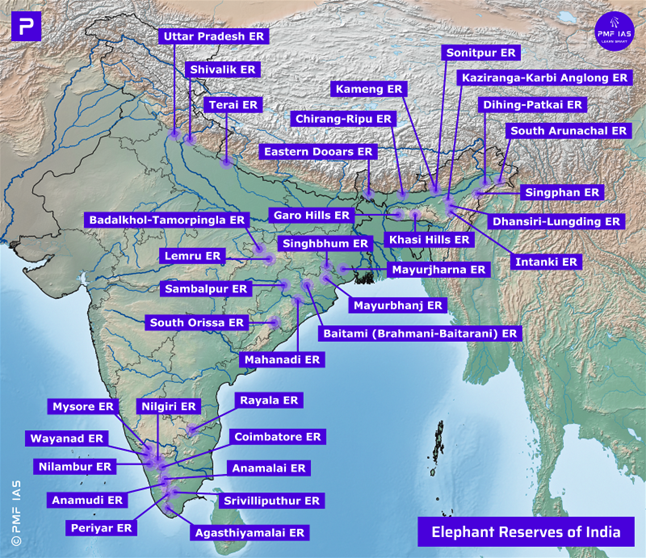
Benefits of Elephant Reserves
Why Elephant Reserves and Corridors Do Little Good for Conservation?
- Elephant reserves and elephant corridors are essentially administrative classifications.
- They don’t promise greater protection of elephant habitats because they are not recognised by law.
- According to the Wildlife (Protection) Act, 1972 (WPA 1972), a ‘protected area’ can be one of a ‘national park’, a ‘wildlife sanctuary’, a ‘conservation reserve’ or a ‘community reserve’.
- The prohibited activities in protected areas, including mining, oil and gas drilling, dams, etc., are permissible in an elephant reserve.
- As a result, governments can divert elephant reserves and corridors for various projects.
Asian Elephant
|
{GS3 – Envi – Conservation} Koya Tribe Help Conserve Indian Bison
- Context (TH): The Koyas of Papikonda Hills switched from Bison horns to palm leaves for their traditional flute, Permakore, as a conservation measure for the Indian Bison of Eastern ghats.
Indian Bison (Bos gaurus)
- Indian bison (or Gaur) is the largest among the wild cattle and the bovids (mammals with cloven hoofs and unbranched hollow horns).
- The domesticated form of the gaur is called Gayal or Mithun.
- Distribution: It is native to South, Southeast, and East Asia. In India, it is found in parts of the Himalayan foothills, NE India, Eastern Ghats, and Western Ghats.
- It is an attraction of Wayanad, Nagarhole, Mudumalai, and Bandipur national parks.
- Trishna Wildlife Sanctuary in Tripura is India’s only natural breeding centre for bison.
- Habitat: It is found in evergreen, semi-evergreen, moist deciduous and dry deciduous forests.
- Threats: Habitat loss, hunting, invasive species and diseases.
- Conservation status: IUCN: VU | CITES: Appendix I | WPA: Schedule I

Koya Tribe
- Koya tribe is found in Andhra Pradesh, Telangana, Chhattisgarh, and Odisha.
- Traditionally, Koyas were soldiers of the palegars (feudal lords) and practised podu cultivation.
- Today, Koyas are mainly settled cultivators and artisans.
Papikonda Hills
- The Papikondalu hills of Andhra Pradesh are also known as the ‘Bison Hill range’.
- In 1978, a section of the hill range was declared a sanctuary, with the Indian Bison as its megafauna.
- The Papikonda National Park was declared in 2008.
- The Polavaram irrigation project and clearing forest for Podu cultivation threatens the park.

{GS3 – Envi – Pollution} E-Waste Management Rules, 2022
- Context (PIB): MoEFCC has revised the E-Waste (Management) Rules, 2016 and notified the E-Waste (Management) Rules, 2022, and the same has been in force since 1st April 2023.
- Under these rules, the collection and processing of e-waste can be carried out only by registered producers, recyclers and refurbishers.
- The Indian Cellular and Electronics Association (ICEA) report (2022) says harnessing e-waste is a $7 billion market opportunity.
Salient Features of the New Rules
- They apply to every manufacturer, producer, refurbisher, dismantler and recycler.
- All manufacturers, producers, refurbishers and recyclers must register on the Central Pollution Control Board (CPCB) portal.
- No entity shall carry out any business without registration and not deal with any unregistered entity.
- Authorization has now been replaced by registration through the online portal, and only manufacturers, producers, refurbishers, and recyclers require registration.
- Schedule I is expanded, and now 106 Electrical and Electronic Equipment (EEE) have been included under the extended producer responsibility (EPR) regime.
- Producers of notified EEE have been given annual E-Waste Recycling targets based on the generation from the previously sold EEE or based on sales of EEE, as the case may be.
- Target may be made stable for 2 years, starting from 60% for the years 2023-2024 and 2024-25, 70% for the years 2025-26 and 2026-27, and 80% for the years 2027-28 and 2028-29 and onwards.
- Management of solar PV modules/panels/cells is added to new rules.
- The quantity recycled will be computed based on end products to avoid any false claims.
- Provision for generation and transaction of EPR Certificate has been introduced.
- Provisions for environmental compensation, verification and audit have been introduced.
- There is a provision for the constitution of a Steering Committee to oversee the overall implementation of the rules.
- Provision for reducing hazardous substances in the manufacturing of EEE mandates that every producer of EEE and their components shall ensure that their products do not contain lead, mercury and other hazardous substances beyond the maximum prescribed concentration.
- It also provides recognition and registration, skill development, monitoring and ensuring the safety and health of workers involved in dismantling and recycling e-waste.
Advantages of the amendments
- The new provisions would facilitate and channelise the informal sector to the formal sector for doing business and ensure recycling of E-waste in an environmentally sound manner.
- It will promote a circular economy through the EPR regime & scientific recycling/disposal of e-waste.
- Provisions for environmental compensation, verification and audit will improve accountability.
{GS3 – Infra – Transportation} Logistics Sector in India
- Context (TH): According to a report by the National Council for Applied Economic Research, logistics cost in India has reduced to 7.8%-8.9% of GDP.
Logistics Sector in India: Status
- Valued around US$ 200 Billion, it contributes 15% to India’s GDP.
- The sector grows at a CAGR of 7-8% since past five years; it is expected to grow at 10.5%.
- 70% of India’s logistics sector remains unorganized.
- Employment potential: Provide employment to >22 million people.
- Leveraging the sector would lead to a decrease of 10% indirect logistics cost facilitating growth of 5-8% in exports.
Challenges of Logistics Sector
- High logistics cost (14% of GDP) vis-à-vis global counterparts (Germany – 8%, USA – 9%, Europe – 10%, Japan – 11%) detrimentally affecting domestic and global competitiveness.
- Poor storage & handling infrastructure: Fragmented warehousing (constituting 10% of logistics costs), insufficient cold storages, and the absence of large integrated logistics parks.
- Inauspicious modal mix: Despite road transport being the most expensive (>60% in India), railways, waterways, and inland water transport remain underutilized.
- Complex tax regimes, administrative delays, and custom clearance impediments: Diverse taxation, multiple regulatory bodies, and policy intricacies hindering development.
- Absence of seamless modal connections: The development of India’s logistics and transport sectors in isolation impedes the smooth movement across land, sea, and air.
- Prolonged turnaround time for ships (approximately 2.2 days vs. the global average of 0.97 days) and last-mile delivery challenges contributing to transit delays.
- Unorganized sector: Over 70% of the logistics sector is small & unorganized, characterized by poor skill levels and inadequate training.
Way Forward
- Encourage seamless integration of various modes of transport, such as road, rail, air, and water, to create a robust multimodal logistics network.
- Continuously review and update policies to create a conducive environment for the logistics sector’s growth.
- Encourage private investment in warehousing, cold storage, and last-mile delivery networks.
- Integrate sustainable and eco-friendly practices in logistics operations, such as the use of electric vehicles and green packaging.
- Utilize data analytics for demand forecasting, route optimization, and inventory management to enhance overall efficiency.
{GS3 – S&T – AI} GPAI Summit and New Delhi Declaration
- Context (IE | PIB | TH): India has successfully hosted the annual Global Partnership on Artificial Intelligence (GPAI) Summit for 2023 at the Bharat Mandapam in New Delhi.
|
Global Partnership on Artificial Intelligence (GPAI)
- GPAI is a multi-stakeholder initiative bridging the gap between AI theory and practice through research and applied activities on AI priorities.
- It will bring experts from industry, civil society, governments, and academia to promote the responsible evolution of AI.
- It is built around a shared commitment to the OECD Recommendation on AI.
- Initially, it will work on four themes:
- Responsible AI
- Data Governance
- Future of Work
- Innovation and Commercialisation
- Its founding members are Australia, Canada, the European Union, France, Germany, India, Italy, Japan, the Republic of Korea, Mexico, New Zealand, Singapore, Slovenia, the UK and the US.
- Launched in 2020 with 15 members, GPAI’s membership now includes 28 countries and the EU.
- India became the Council Chair of the GPAI in November 2022 after France.
|
Organisation for Economic Cooperation and Development (OECD)
|
New Delhi Declaration
- In the 2023 summit. GPAI unanimously adopted the New Delhi Declaration, emphasising:
- Risk mitigation in AI development
- Equitable resource access for AI innovation
- The declaration acknowledges AI’s rapid advancement and recognises its potential for economic growth, innovation, job creation, and societal benefits.
- The declaration also flagged concerns about AI systems, including misinformation and bias, unemployment, intellectual property and personal data protection, threats to human rights and democratic values, deepfakes, cybersecurity, and cyber-terrorism.
- It also agreed to support AI innovation in agriculture as a new “thematic priority”.
- It said that GPAI will aim for diverse membership, prioritising low and middle-income countries.
How does the New Delhi Declaration contrast with the Bletchley Declaration?
- The world’s first AI Safety Summit was held at Bletchley Park in the UK in 2023.
- At the summit, the Bletchley Park Declaration was signed to minimise risks from ‘frontier AI’.
- Thus, the centre of the Bletchley Declaration was security and safety risks related to AI.
- In contrast, the New Delhi Declaration found a middle path between promoting and regulating AI.
- It addresses AI risks but strongly supports innovation in various sectors like agriculture and healthcare.
Frontier AI
|
Change in India’s Position in AI Regulation
- India shifted from its view of no AI legal intervention to actively formulating regulations based on a “risk-based, user-harm” approach.
- Though the Ministry of Electronics and IT (MeitY) acknowledged AI’s ethical and associated risks, it did not consider any law to regulate the AI sector.
- However, after deepfakes of popular personalities gained traction (e.g., actress Rashmika Mandana’s video), MeitY is considering concrete legislative steps to address AI-based misinformation.
- At the GPAI Summit, PM flagged AI’s dual potential as a development as well as a destructive tool.
- He called for a global framework to provide guardrails and ensure its responsible use.
How does the New Delhi Declaration Favour India’s Aspiration for Sovereign AI?
- The declaration supports India’s intention, as Lead Chair for 2024, to endorse efforts to foster collaborative AI for global partnership among GPAI members.
- This is a significant win for India, which has advocated a collaborative approach to building AI systems to push its Digital Public Infrastructure (DPI) model worldwide.
- Besides, access to member nations’ computing capabilities will also boost India’s plans to build a sovereign AI system.
Digital Public Infrastructure (DPI)
India’s DPI Approach |





![PMF IAS Environment for UPSC 2022-23 [paperback] PMF IAS [Nov 30, 2021]…](https://pmfias.b-cdn.net/wp-content/uploads/2024/04/pmfiasenvironmentforupsc2022-23paperbackpmfiasnov302021.jpg)
